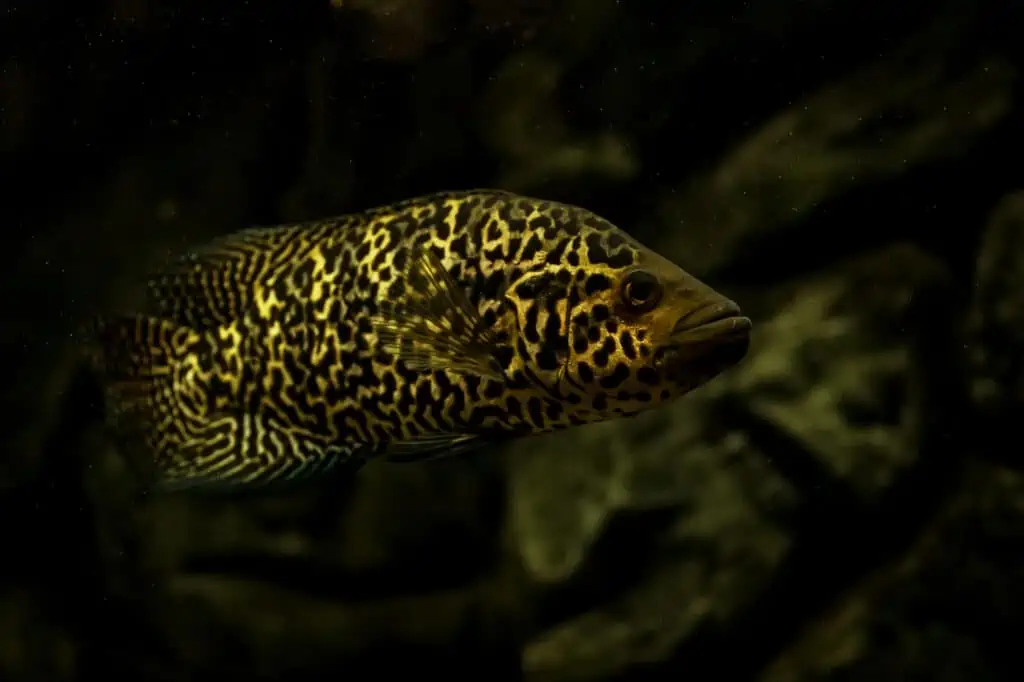Although you might initially shy away from keeping aggressive freshwater fish species in your aquarium, some of the feistiest fish are also the most popular. So, what makes aggressive fish so popular? And are aggressive species more challenging to keep than peaceful ones?
Read this guide to learn the 12 aggressive fish species we actually recommend for your home fish tank!
Most of these fish are not suitable for community life, many exclusively eat live foods, and some are extremely expensive to buy. However, most are pretty easy to keep and are affordable, too, so you’ll find something for everyone on our list.
Enjoy!
Tiger Barb (Puntigrus tetrazona)
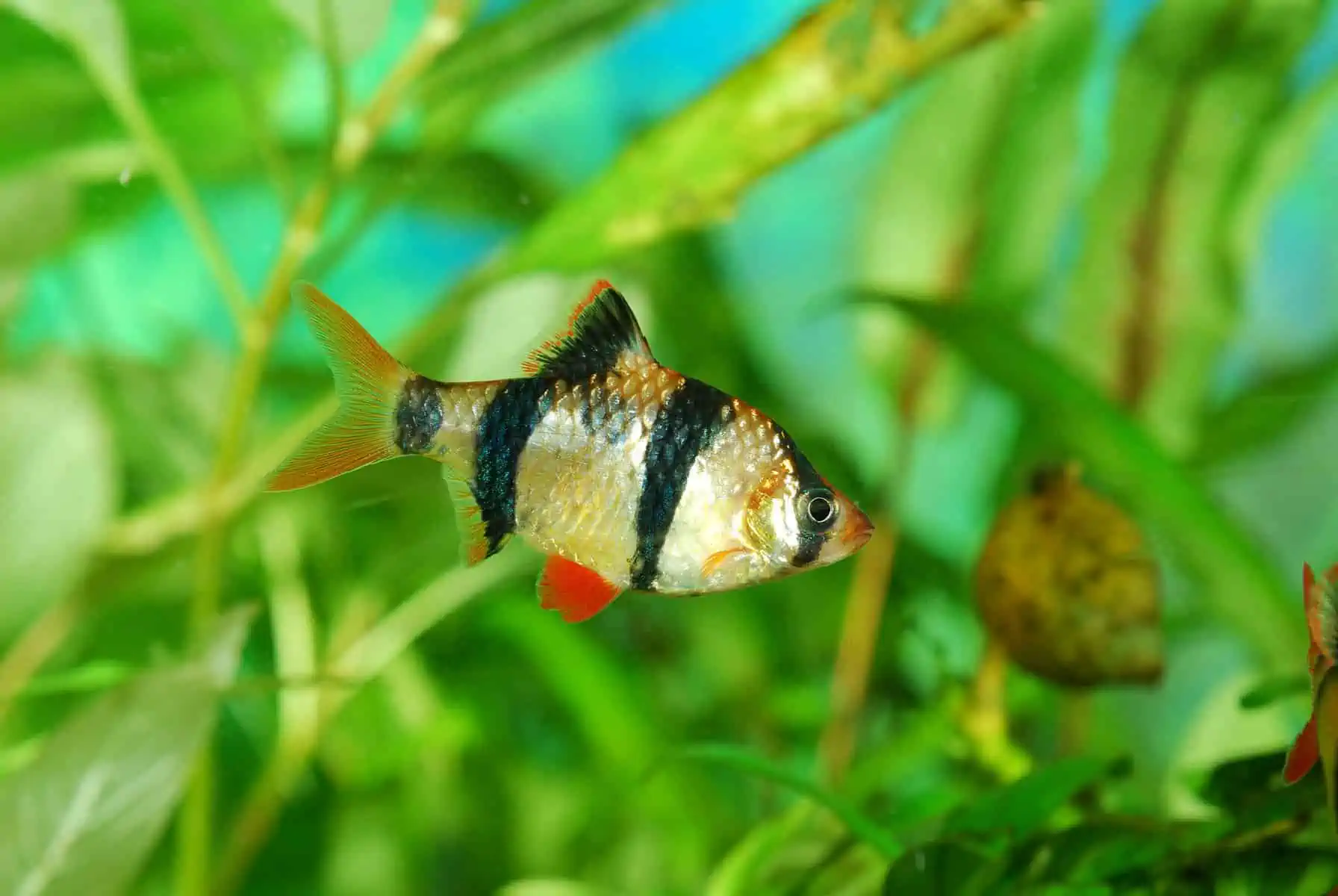
- Care Level: Beginner
- Temperament: Mildly aggressive
- Lifespan: Up to 7 years
- Minimum Tank Size: 30 gallons
- Water Parameters: Temperature 75° to 80° F, pH range 6.0 to 7.0, water hardness up to 10 dGH
Tiger barbs come with a reputation for being feisty, mildly aggressive fish. It’s true to say that these barbs can nip at flowing fins or bully more passive species.
However, with careful planning, you can keep a group of six or more of these semi-aggressive fish in your tank. These are shoaling, active fish, and social interaction can prevent aggressive behavior toward other tank mates. In addition, a group of brightly colored Tigers makes a beautiful display.
These omnivorous, hardy fish prefer soft, slightly acidic water, but they are pretty hardy.
Bucktooth Tetra (Exodon paradoxus)
- Care Level: Intermediate
- Temperament: Aggressive
- Lifespan: Up to 8 to 10 years
- Minimum Tank Size: 55 gallons
- Water Parameters: Temperature 72° to 82° F, pH range 5.5 to 7.5, water hardness from 5 to 20 dGH
Bucktooth tetras are an attractive and interesting species of fish that do best in a single-species fish tank.
These silvery-gray fish have semi-transparent parts of their body, making their silver scales pop even more. The fish also has two black dots and hints of yellow and red colors on its body and fins, adding to the creature’s appealing appearance.
Despite its innocent appearance, the Bucktooth tetra is no pussycat! These fish have an alarming habit of ripping off fish scales and eating them! So, we definitely don’t recommend adding these pretty fish to a community tank.
The safest way to enjoy the Bucktooth tetra is to keep a group of at least 12 of them. Smaller schools might see the fish battling for dominance, so the more fish you can keep in a large aquarium, the better for everyone concerned!
Black Wolf Fish (Hoplias curupira)
- Care Level: Intermediate
- Temperament: Aggressive predator
- Lifespan: Around 10 years
- Minimum Tank Size: 120 gallons
- Water Parameters: Temperature 76° to 82° F, pH range 6.0 to 7.0
The Black Wolf fish is an aggressive predatory fish from the Amazon River Basin. Here, the fish spends much of its time living in the lower reaches of the water column, waiting for prey to swim by.
Although these fish make an impressive showpiece in your home tank and could live in a community with other fast-moving aggressive fish of the same size or larger, these predators are better kept alone.
The Black Wolf fish needs a high-protein diet that consists primarily of live food, although you could wean your fish onto frozen foods.
Dwarf Pufferfish (Carinotetraodon travancoricus)
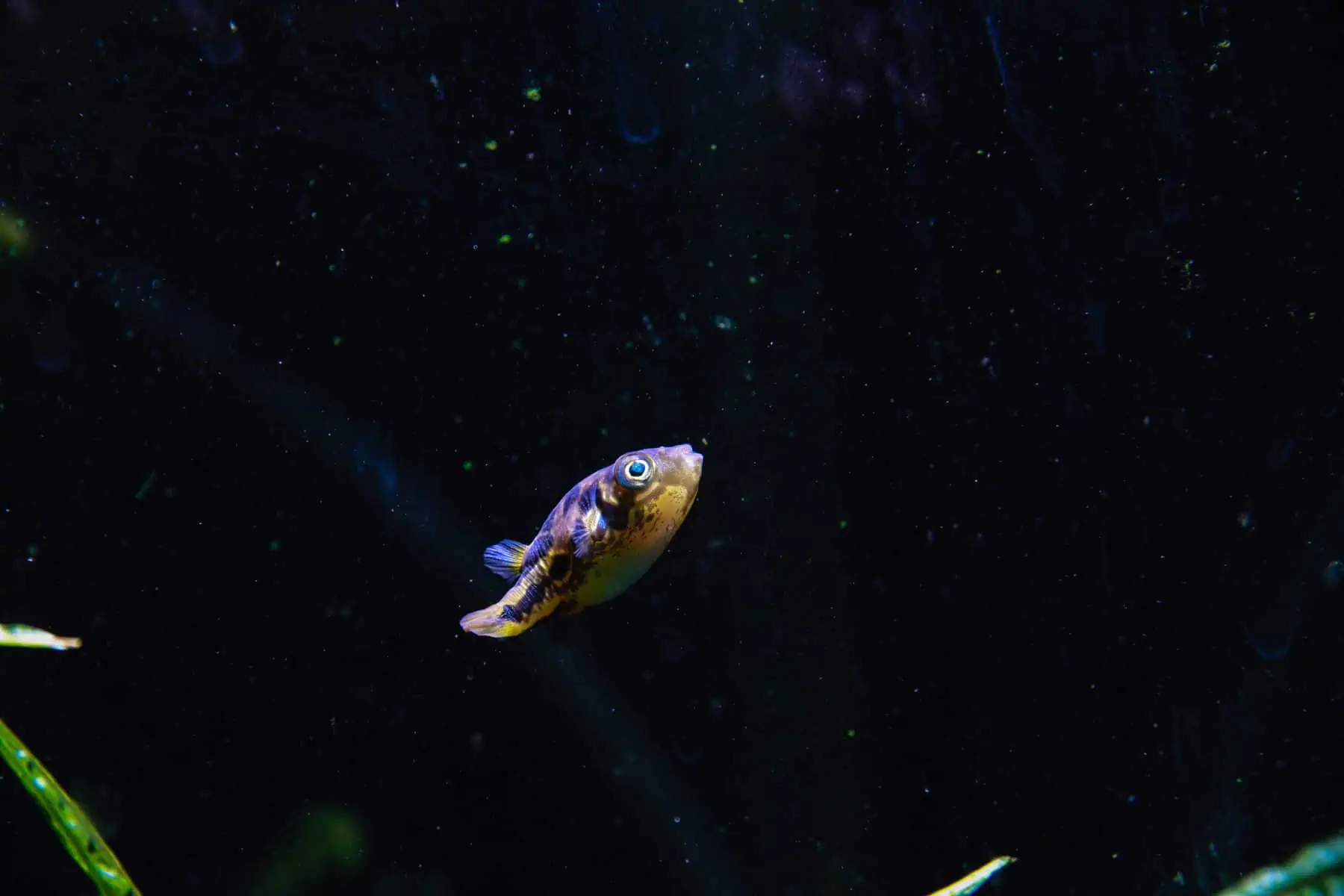
- Care Level: Intermediate
- Temperament: Aggressively territorial
- Lifespan: Up to 10 years
- Minimum Tank Size: 10 gallons
- Water Parameters: Temperature 72° to 82° F, pH range 7.5 to 8.3, water hardness 8 to 15 dGH
Dwarf or Pea pufferfish look like cute nano fish that you would expect to make a nice addition to your community tank. However, these tiny fish are aggressively territorial and will chase off much larger fish that wander into their patch.
Dwarf puffers come from the slow-moving waters of Malabar in southwest India. Sadly, these beautiful, quirky little fish are now under threat due to deforestation and overfishing for the pet trade.
Wolf Cichlid (Parachromis dovii)
- Care Level: Intermediate
- Temperament: Highly aggressive
- Lifespan: Up to 30 years
- Minimum Tank Size: 125 gallons
- Water Parameters: Temperature 75° to 82° F, pH range 6.0 to 8.0, water hardness 5 to 20 dGH
Wolf cichlids are highly aggressive predators that can reach an impressive 28 inches in length!
You can’t keep the Wolf cichlid in a community tank even if you have a massive setup. These fiercely territorial fish will kill other large, aggressive fish if they get too close. Also, the Wolf possesses a mouth full of razor-sharp teeth set in crushing jaws that will make mincemeat of small, vulnerable fish.
Flowerhorn Cichlid (Paraneetroplus synspilus)
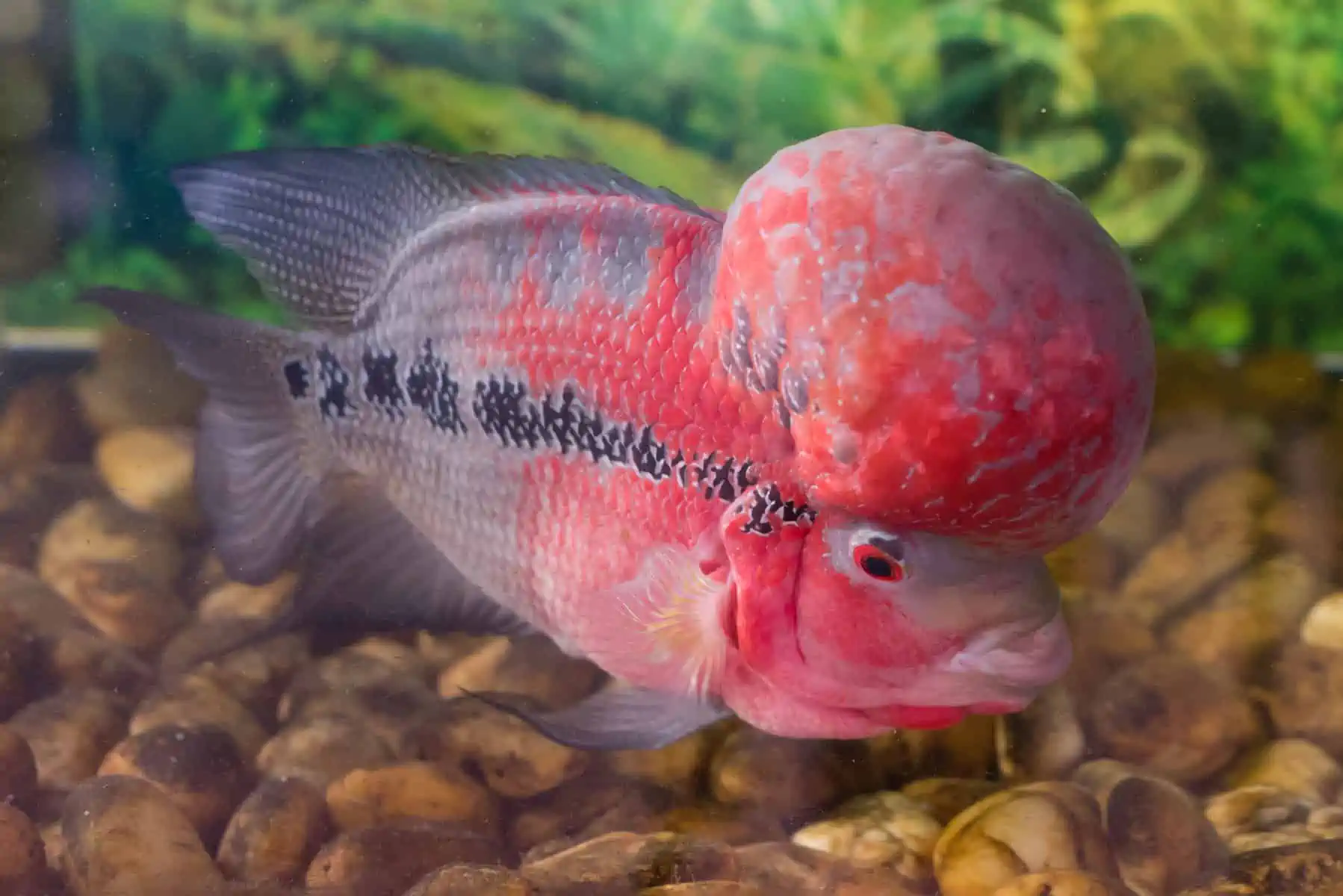
- Care Level: Easy
- Temperament: Territorial and aggressive
- Life Expectancy: Up to 12 years
- Minimum Tank Size: 125 gallons for a pair of Flowerhorns
- Water Parameters: Temperature 80° to 89° F, pH range 6.5 to 7.8, water hardness 9 to 20 dGH
The Flowerhorn cichlid is a completely artificial creation developed as an exotic ornamental fish by breeders in China.
These beautiful fish are often bought from fish stores as small creatures a few inches long, but they swiftly grow to reach up to 12 inches in length! That said, you can buy smaller, so-called Bonsai Flowerhorns that only get to around 6 inches long.
This aggressive cichlid certainly makes an eye-catching addition to any home tank. As a bonus, Flowerhorns are reputed to be lucky fish, bringing good health, good luck, and even influencing their owner’s relationships!
Arowana (Scleropages formosus)
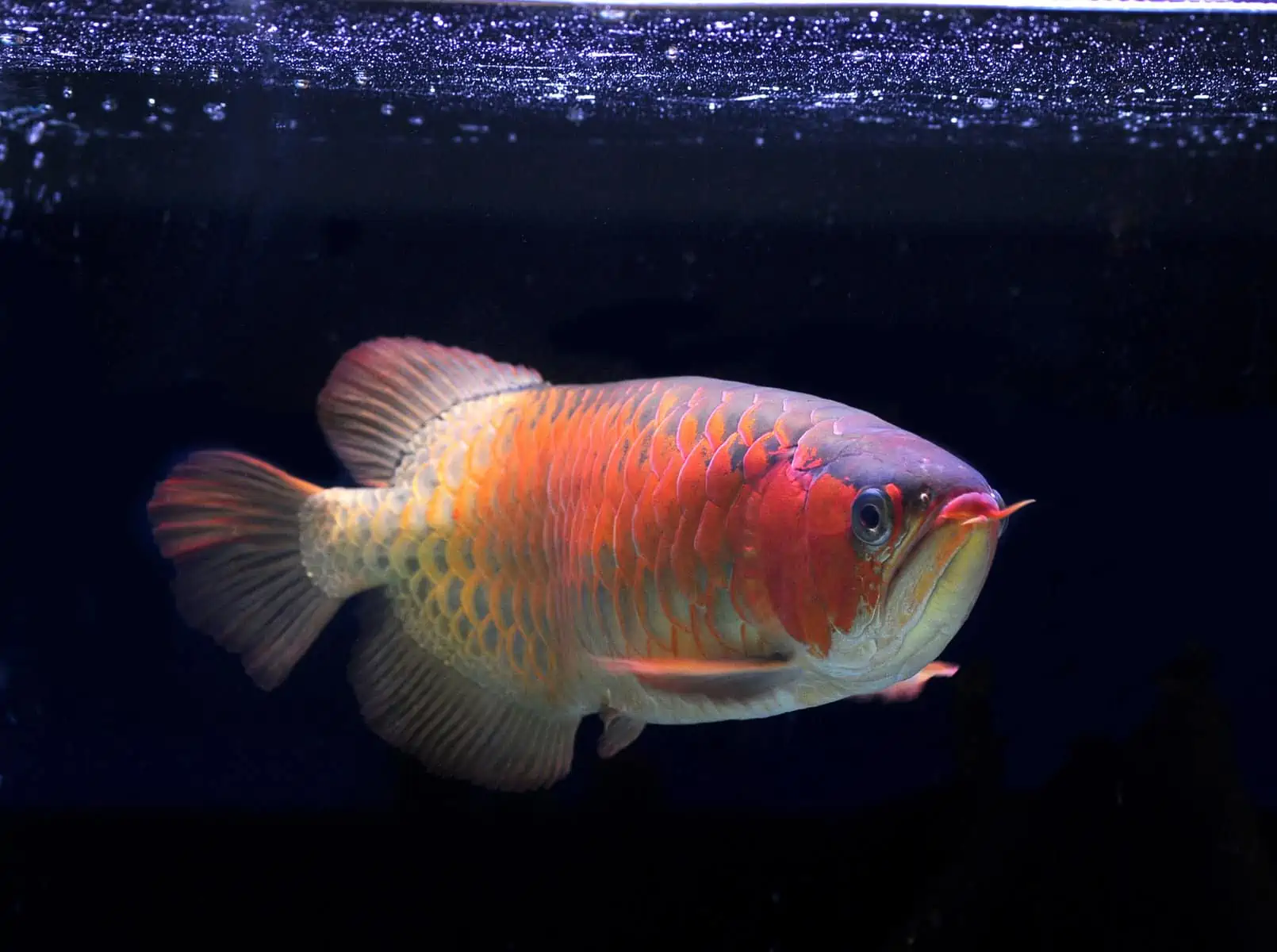
- Care Level: Moderate
- Temperament: Aggressive, territorial
- Lifespan: Up to 50 years
- Minimum Tank Size: 250 gallons
- Water Parameters: Temperature 75° to 82° F, pH range 6.5 to 7.5,
You generally only see the carnivorous Arowana or Dragon fish in public display aquariums due to their colossal size. These fish are also one of the world’s most expensive to buy, with some specimens commanding a price of up to $300,000!
These aggressive carnivores come in green, golden, and red varieties, as well as the silver version, which is generally the cheapest. These carnivorous fish eat a live diet and produce a large amount of waste, so you need to run a very efficient filter system and be prepared to spend time carrying out regular water changes.
Snakehead Fish (Channa lucius)
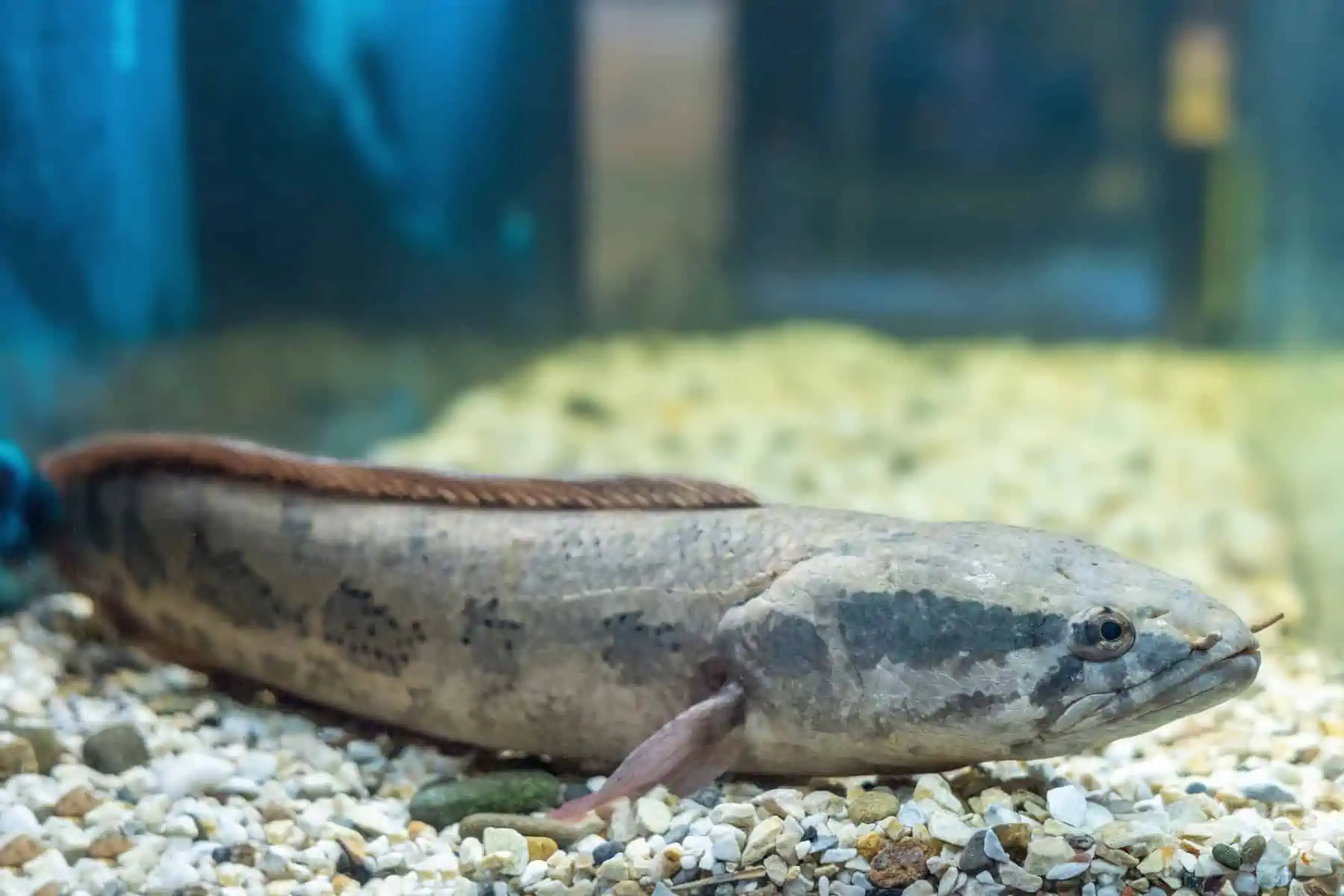
- Care Level: Advanced
- Temperament: Aggressive
- Lifespan: Around 10 to 15 years
- Minimum Tank Size: 150 gallons
- Water Conditions: Temperature 75° to 82° F, pH range 5.0 to 6.5, water hardness up to 8 dGH
The Snakehead is a rare and beautiful fish that can live out of water for up to four days, provided it stays wet! These fish are found across an extensive range, including Afghanistan, Iran, Siberia, China, Senegal, and Africa.
If you decide to keep one of these aggressive fish, be sure that your aquarium has a tightly fitting lid. The Snakehead can travel for up to ¼ mile on damp ground, using its fins and body to writhe along like a snake, which is where the fish gets its common name.
Surinam Aimara Wolf Fish (Hoplias aimara)
- Care Level: Advanced
- Temperament: Aggressive
- Lifespan: Around 30 years
- Minimum Tank Size: 300 gallons
- Water Conditions: Temperature 78° to 82° F, pH range 6.5 to 7.5
Hoplias aimara is an incredible fish not often seen in the trade. These fish have unique care requirements and are not suitable for life in community aquariums, but an experienced aquarist can make owning one of these creatures a joy.
This fish’s aggression level is through the roof and they are fierce predators that hunt down their prey, swimming effortlessly and grabbing their unlucky victim with sharp teeth. When they’re not hunting, the Aimara Wolf fish spends much of its time resting on the bottom of the tank.
Red-Bellied Piranha (Pygocentrus nattereri)
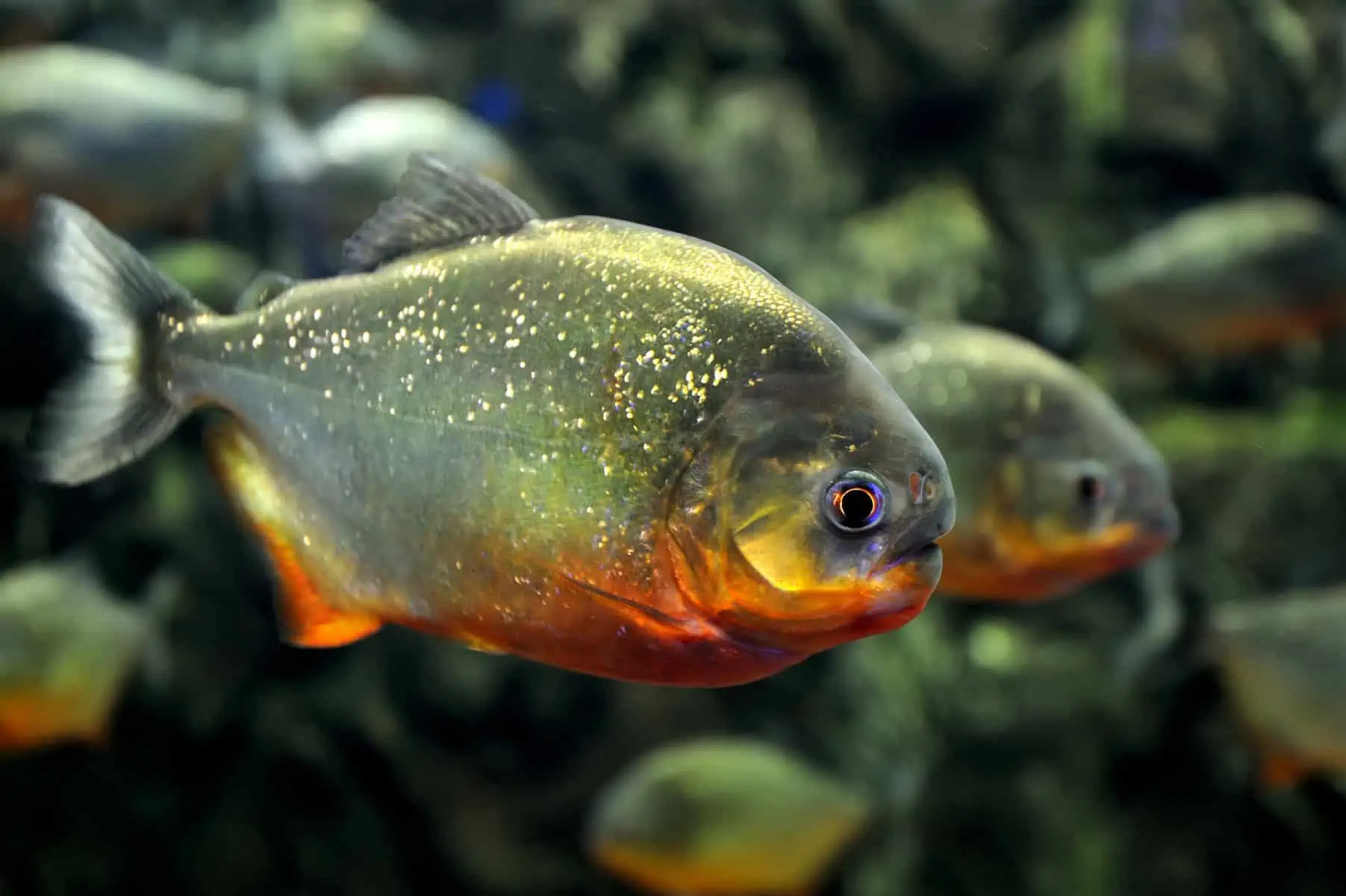
- Care Level: Intermediate
- Temperament: Aggressive
- Lifespan: Around 10 years
- Minimum Tank Size: 100 gallons
- Water Conditions: Temperature 64° to 82° F, pH range 6.5 to 7.5, water hardness 4 to 18 dGH
Many hobbyists regard the Red-Bellied piranha as the ultimate aggressive fish you can keep in your home tank. However, the Black piranha is the more aggressive of the two species that you commonly find in the pet trade.
Red-Bellied piranhas are found throughout the Amazon Basin and in the Paraguay, Essequibo, and Paraná Rivers of South America, where the fish inhabit wetlands, rivers, flooded forests, lakes, and creeks.
Although these fish are quite small, only growing to around 6 inches long, Red-Bellied piranhas are shoaling fish that need to be kept in large groups, making these attractive fish a good choice for larger tanks. The fish are relatively easy to care for, eating a varied diet including plant matter, insects, snails, and fish.
Jaguar Cichlid (Parachromis managuensis)
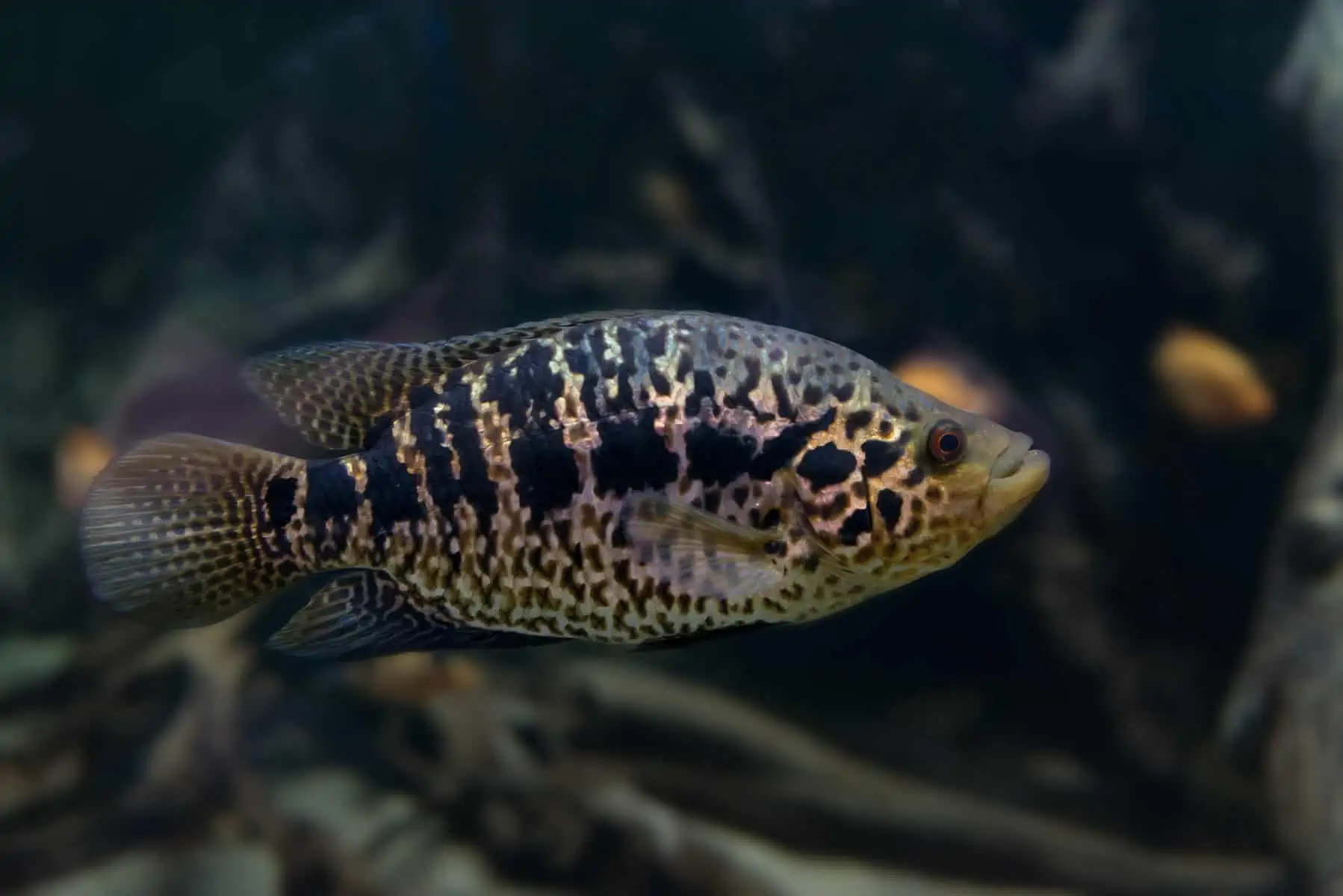
- Care Level: Intermediate
- Temperament: Aggressive
- Lifespan: Around 10 years
- Minimum Tank Size: 240+ gallons
- Water Conditions: Temperature 73° to 82° F, pH range 7.0 to 8.7, water hardness 10 to 15 dGH
The Jaguar cichlid is often overlooked by aquarists setting up a community tank.
These fish are beautifully patterned with a creamy-yellow body featuring striking black patterns, resembling a jaguar. The fish’s patterns change as they mature, only becoming permanent once the fish is fully grown.
Jaguar cichlids can live in a community of other semi-aggressive, larger fishes of a similar size, ideally other cichlids. However, you can’t keep smaller, weaker fish with these guys, as the Jaguars will attempt to eat any fish that’s smaller than them.
It’s also not a good idea to keep multiple Jaguar cichlids together, as they will kill fish of either sex!
Mini Dovii (Cichlasoma grammodes)
- Care Level: Intermediate
- Temperament: Aggressive
- Lifespan: Around 10 years
- Minimum Tank Size: 125+ gallons
- Water Conditions: Temperature 75° to 82° F, pH range 6.8 to 7.6, water hardness 10 to 30 dGH
The Mini Dovii is only around half the size of a Dovii and is not a closely related species. However, these feisty characters are highly aggressive and will cause carnage in the aquarium, killing off anything else that moves, including their own kind.
Although these dominant fish can reach around 12 inches in size, the juvenile specimens you buy in fish stores are generally only a couple of inches long. That said, as these fish are very slow growers, you could start with one in a small tank, as long as you’re prepared to upsize as the fish matures and grows.
Final Thoughts
Did you enjoy our guide to aggressive fish species that you can keep in your home aquarium? Please share the article if you found the information we gave you interesting and helpful!
Many fish featured in this guide can be kept in community fish tanks, as long as the other occupants are of a similar size and temperament.
Some small species will be happy in a modest-sized tank, and others are much larger and need a 350-gallon plus-sized aquarium.
Some of the aggressive breeds we mentioned are very expensive to buy, whereas others are not.
There’s something here to fascinate and inspire every aquarist!
Tell us about the aggressive fish in your collection in the comments box below.

